Boyd Lewis was the last resident of Apartment One, 979 Crescent Avenue, inhabited by Jazz Age journalist Margaret Mitchell and her husband John Marsh from 1925–32.
Those years saw legendary parties, with dancing to the Victrola, outrageous flirting and consumption of all manner of bootleg drinks forbidden by Prohibition, and the writing of a massive Civil War and family history that became the historic novel Gone with the Wind. Lewis studied the life of Mitchell, whom friends called “Peggy,” the remarkable old Victorian house that was her home for seven years, and the intersection of Peachtree and 10th Streets, whose story rivals GWTW as a symbol of Atlanta through its histories.
A Tara on Tenth Street
I was looking at history, at the exact place where a work was created that would define Atlanta around the globe for generations, something that would forever transform Hollywood filmmaking, and all I could think of was how cold, wet and miserable I was.
It was February 1977, and I’d been carrying sodden cardboard boxes and belongings down Crescent Avenue to the abandoned three story apartment building at Peachtree and 10th in the cold, piercing drizzle that usually precedes one of Atlanta’s infamous ice storms. The Hooker Barnes Realty Co. had agreed to let me stay rent-free in the tiny ground floor apartment of the building behind the House of Eng’s Chinese Restaurant as caretaker. “We’ve applied for a demolition permit,” said the Hooker Barnes agent. “We don’t want to have it burned down first.”
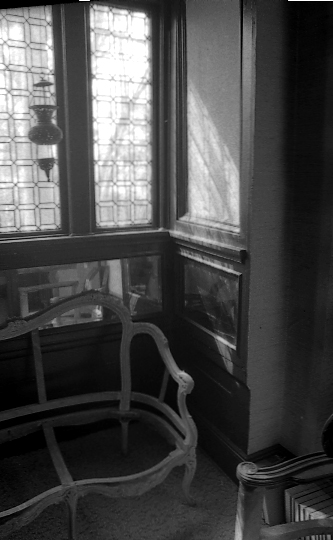
As I busied myself unpacking, the rain stopped. A cold and watery sun tried to appear from the west, down 10th Street but, to my dampened delight, there was enough light to illuminate the front room. Three tall leaded glass windows from another, more elegant century lorded over the western wall of an alcove. They brightened. The little room illuminated. Light frolicked in through a leaded glass design of square-in-square and was amplified by large beveled mirrors inset in each wall of the front room alcove. The effect, in this gloomy old ruin, was pure magic.
I maneuvered an old office chair I’d found on the street into the alcove. This would be where I would read the Atlanta Constitution I bought for 25 cents from the rack in the front of the House of Eng and the books I had brought with me. In this bright little place, the only source of natural light in the entire 650-square-foot dump of an apartment, I would read and be transported from the anxious world of a jobless writer and photographer in Disco Atlanta.
“Did you know that was the Margaret Mitchell House?” a friend asked when I told her of my new living situation. No, I didn’t. In a slab of concrete outside, someone had scrawled “Hippie House” to describe its residents in the early 1970s. That was all I knew. The counter culture had taken over this part of Midtown a few years before and hippies probably had lived there. The apartment building once was one of the grand Peachtree mansions, few of which survived the commercial sprawl. Sometime during the late 1960s it had been glopped over with too much plaster until it looked like a cross between a doll’s house and a cow barn. Up on the second and third levels, doors opened to nowhere. At one time, there had been porches. There was more terminal decay than Tara about this old wreck at 979 Crescent Avenue.
It seemed so unlikely that the author of Gone with the Wind, the iconic but problematic novel of Atlanta, and some say of America, should have lived in this ghastly old ruin, that I went to the old Carnegie Library and leafed through the old newspaper clippings about Margaret Mitchell and her life before and after GWTW. The fragile sepia news clips told that not only had she lived at 979, but in the very apartment I had just moved into, Apartment One, bottom floor left. Living there with her second husband John Marsh from July 4, 1925 until late in 1932, she wrote all but some connecting chapters of her epic novel beginning in the summer of 1926.
The alcove in the front room that illuminated everything with the westering sun coming through those tall columns of glass was the place where literary history was made, where a book would be written with hard cover sales exceeded only by the Bible; a book that gave Hollywood its first blockbuster; the book that for better or worse, defined Atlanta, Georgia, to the rest of the world for generations.
We know that when Peggy and John were living in Apartment One, there was a window seat in the alcove. John brought her a folding blond oak typing table from his work at Georgia Power. With a second hand Remington typewriter and yellow copy paper liberated from her employers at the Atlanta Journal Sunday Magazine, Margaret Mitchell began to weave together stories she had heard since childhood, the histories, tales of her great-aunts who survived the fighting all around Jonesboro on their plantation, remembrances of her Grandmother Stevens, interviews with veterans of the Battle of Atlanta, and stories that paralleled events in her own life.
Journalists of the news lead with the most important facts first in their writing. Feature writers put their big bang at story’s end. Peggy Mitchell, learning her feature reporter’s craft at the Journal, began writing GWTW with the last chapter, Chapter 63. Melanie has just died, Rhett has been drinking and tells Scarlett she is now free to go after Ashley. Scarlett says she never loved Ashley and that it was always Rhett. The gentleman visitor from Charleston coldly tells Scarlett that he doesn’t give a damn and vanishes into the fog. Scarlett, ever the undefeated, swears to get him back. Bam! The end. Now back to the beginning.
Discovering this history was fun, but I didn’t have any water. The latest freeze had burst the upstairs pipes, soaking the Shagadelic 70s orange carpeting in Apartment One and making everything moldy and mildewed. A light brown string of liquid dribbled from the kitchen faucet. The toilet was nonfunctional. Hooker Barnes Realty had promised to “get right on it” when I called, but still no repair, still no water. At long last, the Atlanta/Australia real estate conglomerate told me to hire a plumber and fix the pipes on my own. You’ve got to be kidding, I thought.
At the time, WXIA TV 11 had a consumer feature called “The Newshawk,” where a man named Russ with what appeared to be a stuffed bird on his shoulder solved problems of the citizenry. With unabashed chutzpah and the need to get running water back into my life. I called Russ at 11Alive and pitched my story. The resulting two and a half minute feature profiled one Boyd Lewis, the valiant caretaker of an immensely historic Atlanta property, doing his bit for preservation without the benefit of running water. Good old Newshawk even used the theme from the movie as a sound bed under the entire report.
A truckload of Hooker Barnes plumbers arrived the next day. Water rolled out like a mighty stream from all faucets. But none of it was warm water. No water heater. No luxuries for the caretaker.
Margaret had been married for three months to Red Upshaw, a fellow reporter and part-time moonshine distributor, before divorcing and marrying the quiet, bespectacled best man at her wedding, John Marsh. The newlyweds politely declined Pappa Eugene’s invitation to live in the family home, another of the now-vanished mansions further up Peachtree Street. Instead, they rented the smallest unit in the apartment building carved out of the mansion of Cornelius Sheehan, built for $6,000 in 1899.
After divorcing Red, Margaret told friends she was “coming down from the auction block and getting a job.” A relative had helped start the Atlanta Journal and this helped her get hired as a feature writer for the paper’s Sunday Magazine. Peggy, as her friends knew her, was the latest in a long line of writers who inhabited the building and Apartment One.
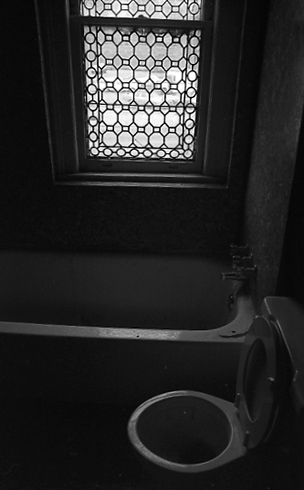
Mr. Sheehan, the man who built the 1899 house, was publisher of Grier’s Almanac. After just six years in the brick mansion, Sheehan, his wife, five daughters, two sons, sister and mother-in-law moved out. Two of the daughters went on to become writers.
By 1915, a printing press had been moved into the ground floor of 979 for publication of Georgia’s only German language newspaper, the Georgian Deutsches Zeitung. The paper was published for only two years before being put out of business by the anti-German hysteria of World War I.
After the War, a new owner jacked up the house and rolled it with giant logs placed under the foundation back away from Peachtree Street so that it faced Crescent Avenue (which had once been Old Peachtree Street). The home’s front yard was sold off for development of little brick storefronts. Sheehan’s 20 year-old mansion was now chopped up into three stories of apartments.
Into one of these apartments came a renter from the Atlanta Journal press room. His name was Weis Snell, and he was a budding sculptor. Peggy had suggested he move into the Crescent Apartments. It was cheap and on the trolley line. Snell showed his gratitude by sculpting a bust of Peggy Mitchell in 1925. One report states that Snell went on to create some of the miniature soldiers used in the Cyclorama depicting the Battle of Atlanta.
The familiar story is often told. Peggy suffered leg injuries as a child when a pony stumbled and fell (shades of Bonnie Blue Butler’s pony tragedy in GWTW). As an adult, she had to wear orthopedic paratrooper-style boots and then, as arthritis set in, had to stay off her feet. To feed her lifelong fascination with the Battle of Atlanta and her family’s role in it, she sent her husband back and forth on the trolley car to the Carnegie Library downtown to check out armloads of books about the Civil War. After several months of this, John is said to have suggested in exasperation, “Peggy, you’ve read all there is about the War. Why don’t you write a book of your own?”
So her life’s work began in the dazzling little alcove, that 50 years later, would enchant another writer with the muse of fire coming in through that tall trio of windows. There, on a portable typewriter and folding table, I wrote “The Citymouse” columns for Creative Loafing.
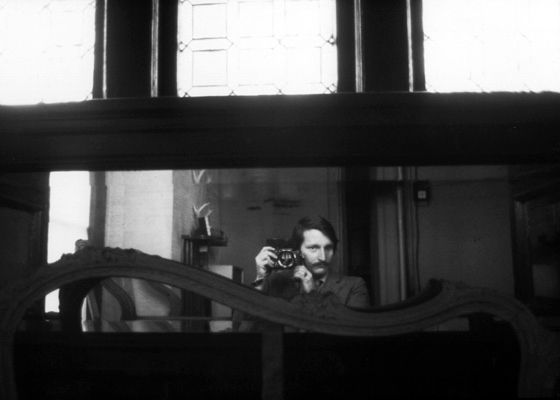
A Halloween Séance for Peggy
Like an unexpected but not unwelcome guest, the Muse of History visited the parties that Margaret Mitchell and I had in Apartment One a half century apart.
Peggy called her rowdy, hard-smoking-and-drinking parties “brawls.” Fellow reporters straight out of Ben Hecht’s The Front Page and socialites who could have been models for Fitzgerald’s The Great Gatsby, packed into Apartment One for impromptu plays and readings about the Battle of Atlanta and Civil War.
Fifty years later, my parties in Apartment One featured a fistfight over the neglect of Historic Oakland Cemetery and a Halloween séance for departed spirits.
It makes sense, of a sort, for this to happen at this intensely historical patch of Atlanta real estate where Peggy Mitchell channeled an entire lost world from 1926 to 1932.
I don’t know how much Peggy Mitchell appreciated irony, but she would have loved the literal brawl that broke out at one of my parties in the summer of 1977. An argument developed between the late Ed Walters, sexton of Historic Oakland Cemetery, and James Zeke Bond, a member of the Atlanta City Council. The disagreement was over cutting city funds for upkeep of the grand old city cemetery, where incidentally, Margaret Mitchell is buried.
The argument soon erupted into a full fledged fight between the sexton and city councilman in the middle room of The Dump. A full length mirror was broken and my answering machine was smashed. This fight over history in the GWTW house was ignored by at least a half dozen reporters taking it easy in the hard-smoking front room.
Almost 50 years earlier, the newlyweds John Marsh and Peggy Mitchell held their first big party on New Year’s Day 1926. Fifteen people were invited but forty showed up and crammed into the 14×14 foot front room. Out came the bootleg hooch and Peggy’s games. There would be charades and pantomimes. “My little playmates,” as Peggy described them, would act out the 1789 Whiskey Rebellion with glasses of bootleg liquor in everyone’s hand.

At one “brawl,” Peggy presented the play Love Comes to General Grant, in which Peggy wrote herself the part of a shady lady (think of one of Belle Watling’s girls) who turned the Union General Ulysses Grant away from attacking Atlanta, thus redeeming her virtue.
“I was one of those short skirted, short haired, hard boiled young women whom preachers said would be hanged or go to Hell before they’re 30,” wrote Peggy Mitchell.
At the brawls, people danced to tunes on the wind-up Victrola and performed Peggy-written skits that parodied history. Partygoers took turns reading from historic and classical books and in a tour de force, Peggy memorized and recited long passages from Steven Vincent Benét’s epic Civil War poem John Brown’s Body.
John wrote and performed ribald limericks including this one: “A shapely fan dancer from Wheeling/Performed with remarkable feeling/Not a murmur was heard/Not a sound, not a word/But fly buttons hitting the ceiling.”
Peggy Mitchell loved practical jokes, melodrama and had the genteel southern lady’s touch of the naughty and bawdy, Over the bed she shared with John, she’d hung a framed brochure for The Adventures of Casanova showing a naked gentlemen climbing into bed with a carefully concealed naked lady.
When a friend asked about the racy print, Peggy said that she and John sometimes engaged in “some thoroughly improper lovemaking.”
Peggy Mitchell once asked the Journal‘s opera critic, bound for Paris, to pick up some legendary French postcards. When he returned, Peggy flipped through the set and told the poor man, “We’ve got better than this here in Atlanta.”
Considering what made Peggy Mitchell laugh, I think the séance we had for her one windy Halloween night was successful.
On October 31, 1977, I threw a costume party in Apartment One to benefit Radio Free Georgia. I had been a volunteer programmer for WRFG and was impressed by the people who populated alternative radio.
A beer keg leaned against the magnolia tree in the backyard to nourish the capering, costumed ghouls who paid as much attention to prohibition of illegal substances as Peggy and her party crew did the prohibition of liquor in the Roaring 20s.
Lenny and La Banana, a pair of New Vaudevillians, juggled flaming torches in the backyard. Costumed Princess Leia and Obi Wan Kenobi from the just-released movie Star Wars wandered majestically lost, looking for wine in the backyard by the wall of the old Bell Telephone Hemlock Exchange building.
As with anything Victorian that survived into twentieth century Atlanta, there was something spooky about the old mansion/apartment at 979 Crescent Ave. A rumor had it that the house was converted into apartments in 1919 because Mrs. Denton, a widow, had been murdered on the third floor the previous year.
During a 1991 tour of the ruins of the Crescent Apartment, Linda DeMars, married to an architect who lived in the apartments in the early 1960s, told me of an eerie experience she had after moving in.
She had moved to the Crescent with her husband, Georgia Tech architecture student Charles and their new baby. One summer night in 1962, she felt a chill and “got the unpleasant feeling that something was with me. It was a frightening presence and although my baby was asleep in the back, I felt whatever it was wouldn’t harm her.”
“I had a friend who was into the occult,” Linda continued. “And I felt the same way when I visited her.”
Something was going on in the psychic and spiritual vortex on that foreboding and ink dark third floor. On this howling Halloween night, I thought it was time to touch the spirit world with a séance.
The third floor had the largest apartment in the building, with a boarded over bay window flanked on the Peachtree Street side by a pair of gargoyles. These were snarling bat heads, a very odd architectural detail for an 1899 building done in faux-Tudor and red Georgia brick.
For the séance, I rounded up a fat white candle, a handful of dry magnolia leaves, and a detached hand from a department store dummy. I recruited about eight friends from the WRFG party downstairs. We trudged up the stairs toward the increasingly quiet third floor, into the jet black dark, a place of gargoyles and rumors of murder.

We sat in a circle around the hand, the candle and the magnolia leaves. Outside, the October wind picked up and made odd aspirations through the cracks around the windows. I asked the group to calm down, get serious and to summon the spirit of Peggy Mitchell, or at least poor Mrs. Denton, who would then move the dummy’s hand to show the veil between the two worlds had dropped. The hand would serve as a makeshift plaster Ouija Board.
Ten minutes passed. Twenty minutes.
The hand rested immobile in its circle of magnolia leaves, mocking us. Only the Halloween wind was abroad on Crescent Avenue. The fat white candle flickered. I don’t know who, but someone began to hum. It was a cross between an “Om” and a groan, but all of us slowly joined in. It became louder.
Suddenly, a loud concatenation of noises filled the room. WHAM! BAM! SLAM! CRACK!
Someone or something was trying to tear the metal fire escape from the front of the building. We all LEAPED. Something outside the bay windows was erupting in a frenzy. I scrambled over to the boarded window and looked through a crack just in time to see a pair of naked butts and waving clothes vanish down the metal fire escape in the clumsy speed of someone caught in the act. Apparently, young love was flourishing on the other side of the boarded up window from our séance when an unearthly Hell-moan came out of nowhere and spoiled their fire escape frolics.
Margaret Mitchell’s risqué spirit would have approved. The veil between our two worlds had lifted for an instant, then had dropped with a chuckle.
Three years before moving to Apartment One, on December 22, 1922, Mitchell had applied for a writer’s job at the Atlanta Journal Sunday Magazine. She was 22 years old and just divorced from first husband, a mean bootlegger and Journal writer named Red Upshaw. Peggy’s only writing experience had been writing tub-thumping South Seas adventure stories as a teenager and a week spent staying with a friend who was on the staff of the News in Birmingham, Alabama.
The formidable editor of the Journal‘s Sunday section was wife of the paper’s editor. Medora Field Perkerson was doubtful about hiring the would-be journalist. “Debs sleep late and don’t go for jobs,” she said.
Charm won out however, and Peggy was hired, still learning how to type. Her salary was $25 a week.
Her first major story was not promising. She handed in an article about an Atlanta woman just returned from Rome. Peggy wrote about how the woman gushed about the season’s Italian fashions. She then casually wrote at story’s end that the touring Atlantan had witnessed Benito Mussolini and his fascist black shirts march into Rome and seize the government. Didn’t this girl know what real news was? Medora demanded a rewrite from Peggy.
The Journal‘s staff in 1922 read like a lineup of some of the brightest talents in American journalism. Grantland Rice had the sports beat. Don Marquis was a feature writer. Erskine Caldwell wrote obituaries. Robert Ruark covered the cop shop, and Frances Newman wrote society and gossip. Everyone would write books.
Peggy wrote hundreds of articles for the Journal in the four years she was at the paper. Features included stories on women bandits, spelunking, Confederate veteran interviews, and a one-on-one with the smoldering sheik of cinema, Rudolph Valentino. Mitchell’s verdict? “He was a very weary sort of person.”
Later stories were frothy flapper fillers about “society’s darlings and their smart bobs” and “Atlanta’s Young Intellectuals.” Then there were features like “Spirited Heroines and Knee Length Skirts” and the more ominously erotic: “Should Husbands Spank their Wives?”
When she moved into “The Dump,” her private writing took a more serious turn, and a dangerous one, in a city and state virtually run by the Ku Klux Klan. Before starting on GWTW, she had nearly completed one of her early unpublished novellas, ‘Ropa Carmigan. Details are sketchy, but it seems to have been a ghost story about the South’s greatest taboo, interracial love. Mitchell wrote an Othello-like tragedy of the doomed love between Europa Carmigan, a plantation owner’s daughter, and a handsome slave. The manuscript was accidentally included in the suitcases containing GWTW sent to the publishers in New York. Aghast, she realized her error and demanded ‘Ropa be sent back. The manuscript was burned by John Marsh after her death in 1949.
‘Ropa was simply too incendiary to ever be made public by the poster girl of the Lost Cause.
By 1929, the brawls had pretty much stopped and Peggy divided her time between writing her novel and caring for John, who suffered from gallbladder problems and “nerves.”
In 1932, John got a promotion in the Georgia Power publicity department with a higher salary. The couple was able to move out of the Dump and into the light-filled Russell Apartments at 4 East 17th Street. The disheveled GWTW manuscript was repacked in all its ratty manila folder glory and tucked away in the spacious new apartment for another two years before being discovered and published.
John and Peggy were gone from the Crescent Apartments. Not much rented during the Great Depression, and the building sat mostly empty.
But the storyline for 979 Crescent continued to play out, for the house was a character as compelling as any in fiction. The house and the land around it took turns in shaping Atlanta history.
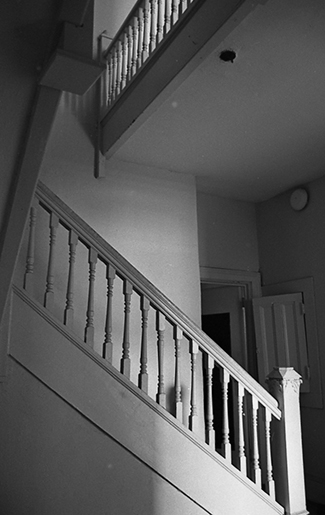
The Land, Scarlet, the Land
Before the Book, there was the House. Before the House, there was the Land. Before the Land, there were the Ridge and the Gulch.

Directly in front of the Margaret Mitchell House is Peachtree Ridge, the massive spine of Atlanta, an eight mile long granite high way that soars nearly 1,050 feet, making Atlanta one of the nation’s highest major cities.
Before the coming of humans, animals had tracked the ridge, following scents high above predators. Following the well-worn animal track, the first peoples to live in this part of northern central Georgia, the Muscogee, or Creeks, walked down the slope of the Ridge to the largest settlement in this part of Georgia until the founding of Atlanta.
The Ridge meandered, rose and fell, all the way to Standing Peachtree, a well-established trading post of the Creek nation on the eastern bank of the Chattahoochee River. The earliest mention of Standing Peachtree was in 1782. (The trading post was on land now occupied by the Atlanta Waterworks Pumping Station.) Just across the Chattahoochee was the land of the Cherokee. Standing Peachtree was an active intertribal trading matrix. It would remain so until the coming of Europeans.
Removal of Native Americans from Georgia began in the 1830s. Wagons replaced warriors on the Peachtree Trail, the new name of the path along the Ridge. Draymen and wagoneers would load crates at the bustling railroad yards and overflowing warehouses of Atlanta and follow the Peachtree Ridge north.
The destination of traffic along the Peachtree Ridge would no longer be a Native American settlement on the banks of a river, but Buckhead, a rowdy little town that served as gateway to the southern highlands, Georgia’s very own St. Louis.
There were wagon yards, mule skinners, saloons decorated with deer heads, and Houses of Ill Repute.
As the wagons approached what is now Peachtree and 10th Streets, they were forced to made a sharp crescent-shaped detour to the west around a 30-foot-deep gulch that opened up in the flank of the ridge between 8th and 12th Streets and plunged northeast all the way to Piedmont Park. It was heavily wooded with a quick-flowing stream and wetlands at the bottom.
During the 1864 Battle of Atlanta, Union General Thomas’s regiments of the Army of the Cumberland were attacked at Peachtree Creek by Confederate General Hood’s Army of Tennessee. Thousands of soldiers died in the fighting. After resisting the fierce, unsuccessful Rebel attack at the Battle of Peachtree Creek on June 20, 1864, the exhausted and bloody Union soldiers made their way south along the wagon paths of the Peachtree Trail until they came to the Gulch, an oasis with its sheltering trees and running water. Here they filled canteens and washed wounds before marching south down the ridge into the cannons of Fort K which straddled the Peachtree Ridge where the Fox Theater and Georgian Terrace Hotel are today.
Fort K was designed by Colonel L.P. Grant who was put in charge of Atlanta’s defenses. The fort consisted of a hollow square of logs and earth, bristling with cannons to repel the Yankee invaders. It was one of the last impediments to invading Atlanta proper from the north for the Union army. (Colonel Grant, who gave the city’s Grant Park its name, had built a mansion that was later purchased for restoration by an Atlanta woman fascinated by the War. She was Margaret Mitchell.)
After a brief rest at the Gulch, the Union troops moved south along the ridge toward Fort K. It was July 22, 1864, and the Battle of Atlanta was in its endgame.
The social upheaval following the collapse of the Confederacy less than a year later was played out in the Gulch, where freedmen, Sherman’s bummers, morphine addicts and ex-Rebs camped out and made it dangerous for honest folk to be near Peachtree and 10th Streets.
During Reconstruction, the area became known as “Tight Squeeze” because, it was said, it took a tight squeeze to get through the neighborhood without being robbed or worse. Tight Squeeze ran from 8th to 12th streets, and for several years, it was a dangerous place out in the country where a gully-dwelling snake nation lived and preyed.
“Tight Squeeze” appears in Gone with the Wind as the place where Scarlett O’Hara is in her wagon crossing a bridge over a stream when she is set upon by Tight Squeezers. She is rescued by Big Sam, her former slave.
The murder of some prominent citizens around Tight Squeeze brought a squad of “secret detectives” into the encampment to clean things up. By 1868, the end to the Robber’s Roost in the Gulch was at hand.
In typical Atlanta fashion, the area was rebranded “Blooming Hills.” Meadows and pastures spread west down Bleckley Road (now 10th Street) and the carpet of flowers and budding trees gave Tight Squeeze its more palatable name.
Morally uplifting developments included a Temperance Hall and a Lodge of the Knights of Jericho. Atlanta annexed the wild countryside into the city limits in 1887.
The old Tight Squeeze gulch began to be filled in. The free flowing stream was rerouted underground as it made its way to Piedmont Park.
The streets were unpaved, but by the 1890s there were 20 blocks of great mansions of every conceivable style along the dirt streets of Peachtree and West Peachtree. Turreted galleons sailed on red dirt.
The road around the Gulch was straightened out and Old Peachtree Street became Crescent Avenue, as a nod to the crescent shaped detour.
The only thing remaining of the old Tight Squeeze Gulch would be a steep decline, visible today, to the parking lots at the northeast corner behind a line of 10th Street shops.
Diagonally across the street from the now-tamed Gulch, Cornelius J. Sheehan chose Land Lot 106 to build his family home on an acre of land. It was a two-story red brick Tudor style mansion large enough for his wife and seven children. Sheehan, a railroad baggage supervisor, paid $6,000 to build this future birthplace of Gone with the Wind.
The original Sheehan mansion had coal fireplaces, gas and electric lighting, and hot water room heaters on the ceilings. There was a dumbwaiter connecting the floors and a large central hall. The interior was finished out in white enamel and oak.
The Sheehans only lived in the house six years until it was sold in 1906. It changed hands several more times in a few years.
Between November 1913 and April 1914, a new owner removed the house from its foundation and rolled it on giant logs away from Peachtree Street. Now fronting Crescent Avenue, the house was jacked up again and an additional story was added.
This is when the house became home to Georgia’s only German language newspaper, the Georgian Deutsches Zeitung.
In 1919, the former Sheehan place became the Crescent Apartments and porches were added to the three story building.
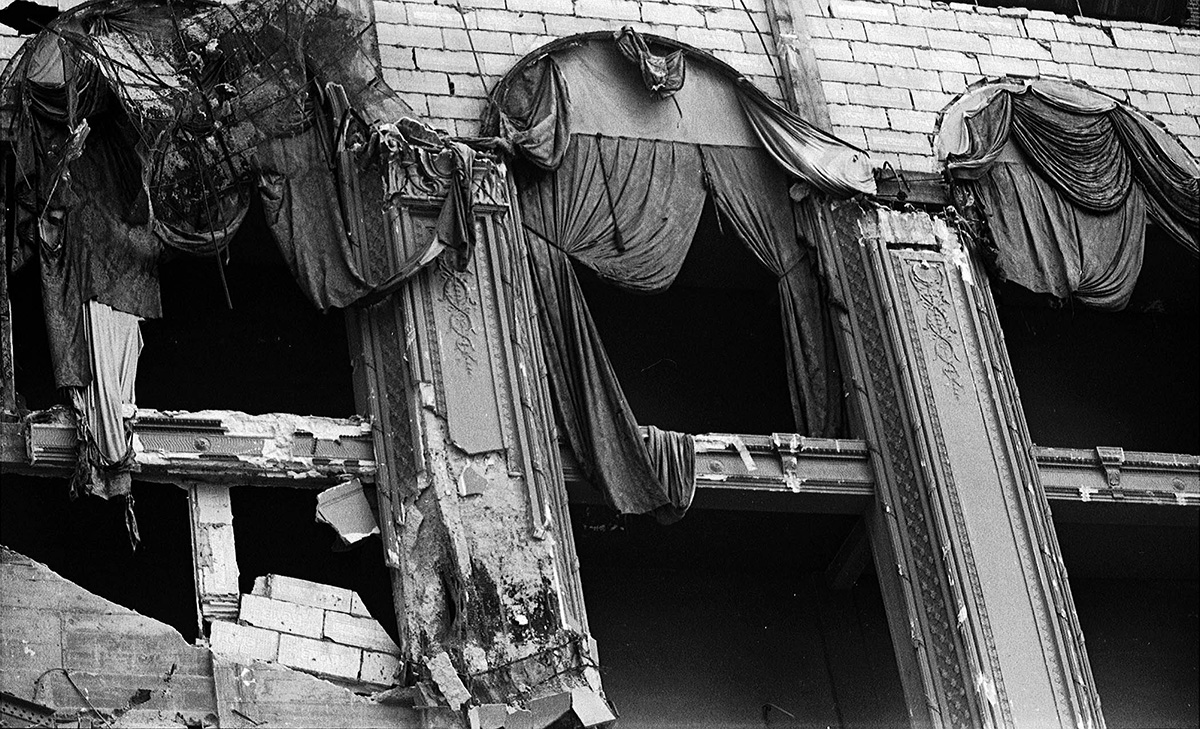
Six years later, Margaret Mitchell and John Marsh moved into Apartment One after their July 4, 1925 wedding.
In 1946, Mrs. Mildred Neeson bought the house and lived there alone as it deteriorated around her. In 1952, the rotting porches on the Crescent side were torn down and the building faced condemnation by the city. Mrs. Neeson cut a providential deal with a group of Georgia Tech students in 1954 to fix the house in exchange for a period of “rent forgiveness.”
The Tech students christened their new off-campus dorm “The Palazzo.”
Resident of “The Palazzo” Charles Demars said, “We all knew it was where GWTW was written. The landlady took it seriously and only rented Apartment One to writers.”
As early as 1962, Peachtree and 10th was called “Atlanta’s Greenwich Village” by the local paper. The boys from Tech had brought their cosmopolitan tastes with them. Dance studios, open air flower markets, and little art galleries like the Mandorla flourished. Jazz. Danskins. Coffee with sticks of cinnamon. The area around Peachtree and 10th now included a foreign film theater and Remond’s French Restaurant. Atlanta’s Bohemian scene had arrived. Only the Piggly Wiggly grocery betrayed the rising sophistication of Atlanta’s first trendy neighborhood.
The late Bud Foote lived across the hall from Apartment One. Foote was a Georgia Tech English professor and was considered a world-renowned scholar of science fiction. He also wrote and performed Woody Guthrie-like folk songs. His backyard parties were the stuff of legend.
During the turbulent years of the civil rights movement, SNCC volunteers took temporary refuge in the house before heading out to Alabama or Mississippi. Backyard concerts were said to have featured jazz and folk greats like Cannonball Adderly, Buffy Sainte-Marie, Ramsey Lewis and Jeff Espina.
A resident painter, Jim Bray, decided to burn all of his paintings in the backyard. He doused the stack with mineral oil and WHOOSH. The flames reached the second story and damn near set the whole building ablaze.
Bray used nude models, and women in the building next door thought it was a vice ring and called the police. The sweet old Mrs. Neeson was threatened with a charge of running a house of ill repute, and in a panic, sold the property for $10,100 in 1964. Everyone was evicted.
One legendary resident of the Mitchell House was Mother David, a former student at the Atlanta Art School. David Braden ran an art gallery and founded Atlanta’s first coffee house, the Catacombs. Braden was also the first major figure of the next cultural wave that would engulf Peachtree 10th, Hippieism.
The Sheehan mansion, or Crescent Apartments, or Margaret Mitchell’s apartment was at the epicenter of Atlanta’s counter-culture revolution. The legendary underground newspaper The Great Speckled Bird was published in an old house four blocks away. Around 1970, what remained of the Gulch had been turned into an outdoor stage (“People’s Square”) for musicians. Mayor Sam Massell directed the police to lay low as some 5,000 long hairs and counter-culturists gathered to groove at Peachtree and 10th.
Sometime around 1971, the stage got a companion: a giant blue and white plaster statue of Jesus, his arms out in benediction with one hand flashing the V-for-Peace sign over the Tight Squeeze gulch. This was the “Peace Christ” who blessed the long haired multitudes along Atlanta’s Hippie Strip.
The Strip began to change around 1973 when streams of the Outlaws biker gang bullied their way into the mellow neighborhoods of the flower people. Many of the thousands who came for the glitz, dope, and music of the strip decamped. A tawdry new chapter in the story of Peachtree and 10th was about to begin.
Many vacant hippie head shops were destroyed by a series of arson fires. The surviving stock rapidly became the center of Atlanta’s Tenderloin, its Reeperbahn, its sex industry. Ten of the city’s 17 “bathhouses” were located within two blocks of Peachtree and 10th. Hookers took control of the sidewalks.It was the season of “Gitcha gitcha ya ya ya” in Tight Squeeze. Alarmed city business leaders responded by launching the Peachtree Walk project, and by 1980, the red lights went out at Peachtree 10th.
Botched renovations, careless tenants and problems with the plumbing and wiring emptied the Mitchell House by 1976. A demolition permit was sought by the owners who wanted the land for a high-rise at Peachtree and 10th Streets.
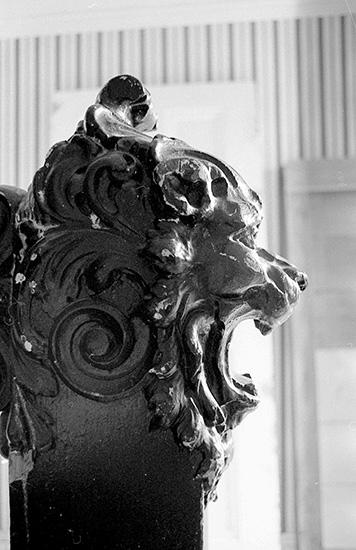
Atlanta’s second downtown was rising over the ghost of Tight Squeeze and the prospects of saving the Margaret Mitchell apartment appeared dim.
As the building decayed into a forlorn heap and new skyscrapers sprouted around it, the arsonists tried to destroy the derelict building.
The fires began in 1981, and arsonists hit again in 1985, 1994 and 1996.
As part of the 1994 Arts Festival, The building became a “site work” for a Japanese artist, Ritsuko Taho. She had asked people to write their dreams on multicolored paper to be placed inside vinyl surgical gloves. The gloves were then blown up and affixed to the steep roof, all 40,000 of them.
At around 4 a.m. on September 17, 1994, an arsonist poured a trail of kerosene from ground floor to third floor. By the time it was alight, a thunderstorm had broken out, but the combination of kerosene and flaming 40,000 vinyl gloves succeeded in nearly destroying the building in a Wagnerian apocalypse of fire and storm.
“At first I was very sorry,” said the artist. “We had 40,000 dreams on the roof. I think that kind of fire could be seen as an indication that dreams can come true. The fire eternalized the dreams. It is almost like a god tried to take their dreams. It seemed to me quite mysterious. And it happened in the city of the Phoenix, Atlanta.”
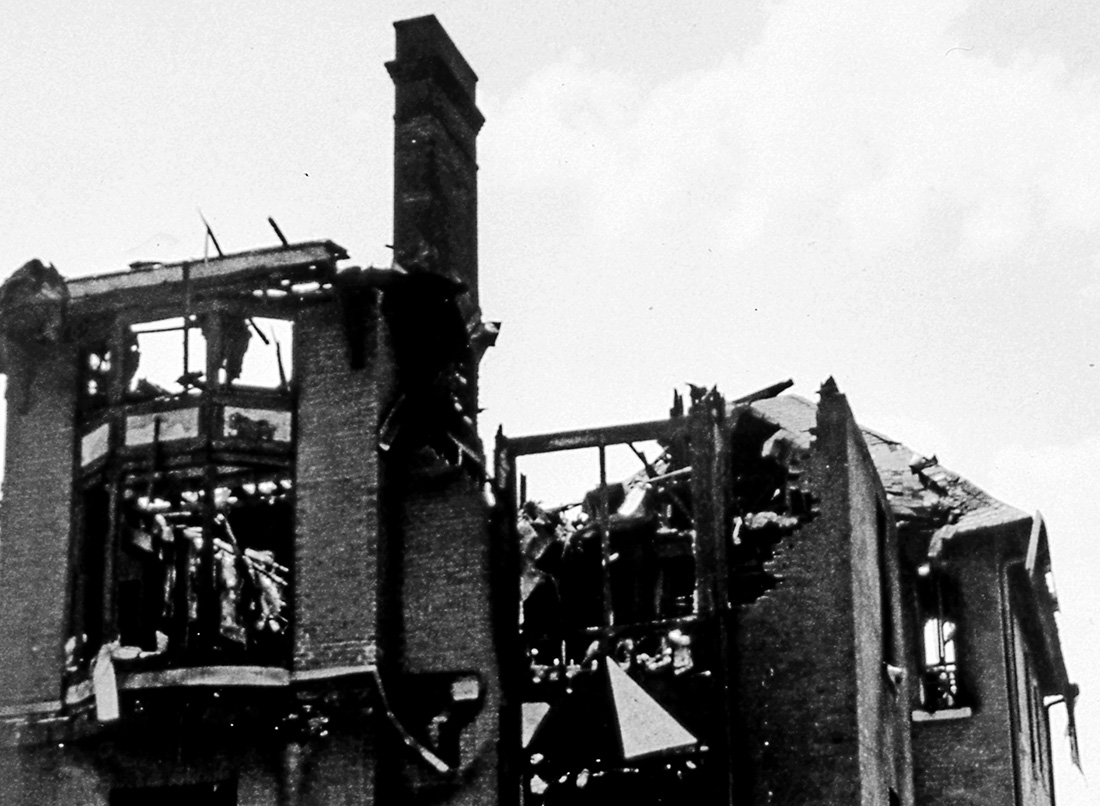
Images and text © Boyd Lewis, 2015.
Citation: Lewis, Boyd. “Living at Peggy’s: Where Margaret Mitchell Wrote Gone with the Wind.” Atlanta Studies. December 19, 2014. https://doi.org/10.18737/atls20141219.



